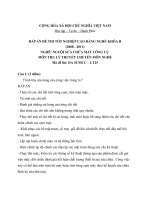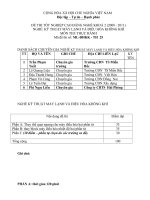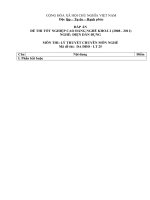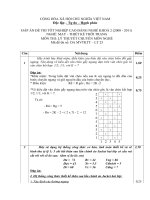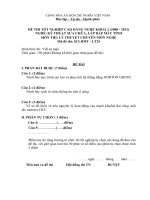25 textile testing methods
Bạn đang xem bản rút gọn của tài liệu. Xem và tải ngay bản đầy đủ của tài liệu tại đây (1.36 MB, 42 trang )
TEXTILE TESTING
METHODS
INTRODUCTION
Fabric testing is an important segment of the
textile industry. We can easily detect the faults of
machinery and materials during test of textiles.
Textile standards: Standard is a prescribed
required level of performance of material. These
standards are:
• NFPA: National Fire Protection Association
• ANSI: American National Standard Institute
• ISO:
International
organization
for
COTTON
Co tto n fibe r is a single
elongated cell.
Under a microscope, cotton
fiber looks like flat, spirally
twisted ribbon-like tube with
rough granular surface.
Mercerized cotton does not
have natural twist. The finishing
process makes them swollen,
straight, smooth and round with
a shining surface.
Microscopic
view of cotton
WOOL
Wo o l fib e r has irregular,
roughly cylindrical, multi
cellular structure with tapered
ends.
Under a microscope, three
basic layers are showne p id e rm is (outer layer), c o rte x
(middle layer) and m e d ulla
(inner layer).
Medulla is seen only in coarse
and medium wool fibers and
that too under a highly powerful
MICROSCOPIC
VIEW OF WOOL
LINEN
Line n fib e r, under a
microscope, looks like having
multiple sided cylindrical
filaments with fine pointed
edges.
The filaments show nodes at
intervals.
It, in fact, looks like a bamboo
stick having joints that results
into a little unevenness.
Microscopic view of
linen/flax
SILK
• S ilk fib e rs are straight and
smooth.
• Raw silk fiber, composed of two
filaments, has elliptical shape
under the microscope.
• The two fine and lustrous
filaments are shown clearly
looking like transparent rods with
triangular shape.
• Wild silk or tussah fiber has
different appearance than the
cultivated silk. It is flattened,
coarse, thick and broader fiber
having fine, wavy lines all across
its surface whereas cultivated silk
is narrower fiber with no marks on
MICROSCOPIC
VIEW OF SILK
POLYESTER
• Polyester (aka Te ry le ne ) is a category of polymers which
contain the ester functional group in their main chain.
• Generally, polyester fibers are smooth and straight and the
cross-section is round.
• With various finishing processes, its appearance changes in
context of texture and luster.
MICROSCOPIC VIEW OF POLYESTER
NYLON
The basic microscopic appearance is generally fine,
round, smooth, and translucent.
Sometimes it has shiny appearance. If it looks dull, it will
also be dotted under the microscope.
It is also produced in multilobal cross-sectional types.
MICROSCOPIC VIEW OF NYLON
PHYSICAL TESTS
BREAKING
STRENGTH
TEARING STRENGTH
BURSTING
STRENGTH
PILLING PROPENSITY
AIR PERMEABILITY
ABRASION
RESISTANCE
BREAKING STRENGTH
•
•
Bre aking s tre ng th is the force required to
break a fabric when it is under tension (being
pulled).
Bre aking lo ng atio n is the increase in length
that has occurred when the fabrics breaks.
BREAKING STRENGTH
• Mainly used for woven fabric because the tests
are unidirectional and woven fabrics have
unidirectional yarns.
• Factors that produce a strong fabric include
fiber content, yarn size and type, weave, and
yarns per inch.
• Bre aking s tre ng th is expressed in p o und s
and the e lo ng atio n is expressed as a p e rc e nt
and in both cases a number of warp tests and
weft test are performed.
IMPORTANCE OF BREAKING STRENGTH
TEST
• Breaking strength is important in various end
uses such as automotive safety belts,
parachute harness and pants.
• Breaking strength can also be used to test the
effects of destructive forces upon a woven
fabric including sunlight, abrasion, laundering
etc.
TEARING STRENGTH
Te aring s tre ng th is the force required to
continue a tear or rip already stated in a fabric.
• This test is us e d m ainly in
wove n fabrics because the test
is unidirectional and woven
fabrics have unidirectional
yarns.
• A number of tear strength test
is carried out and the average
is taken to determine the tear
strength.
• Tearing strength is e xp re s s e d
e ithe r in p o und s o r g ram s .
BURSTING STRENGTH
Burs ting s tre ng th is the amount of pressure required to rupture a
fabric.
• In this test, the testing force is applied radially and not in one
direction as in breaking or tearing strength tests.
• Fabrics like knits, felt, non woven, lace and netting are usually
tested in this manner because these fabrics either do not have
yarns or yarns are not in any given direction.
• The bursting strength is e xp re s s e d in p o und s .
PILLING PROPENSITY
Pilling is the formation of small balls of fibres called pills
on the surface of the fabric.
• Pilling occurs only when there is
rubbing or an abrasive action on
the surface of the fabric.
• Pilling usually occurs during
normal wear and also while
clothes are in the dryer
• Evaluation should be made taking
into account the size, number, and
visibility of the pills as well as the
type and degree of other surface
PILLING PROPENSITY
After each test, each of the specimen is first evaluated for pilling
usually on a 5-4-3-2-1 p illing s c ale , then surface appearance is
evaluated both for colour change as well as for fuzz.
An average of ratings is usually taken as a result.
AIR PERMEABILITY
Air p e rm e ab ility is the rate of air flow through a material
under a differential pressure between two fabric
surfaces.
This property is important for a wide range of textile
applications.
With some products like curtains high
air permeability is required and for
other products like parachutes and
gas filters air permeability required is
very less.
Air permeability is expressed as c ub ic
fe e t p e r s q uare fo o t o f fab ric at a
stated pressure differential between
two surfaces of fabric.
VARIABLES WHICH AFFECT AIR
PERMEABILITY
Fibe r c o nte nt: more crimp, lower air
permeability.
Yarn s ize : heavier yarns, lower air permeability.
Yarn Twis t: less twist, less air permeability.
Fabric Thic kne s s : thicker fabric, lower air
permeability.
Multiple laye rs : more layers, lower air
permeability.
Fabric yarns pe r inc h o r s titc he s pe r inc h:
greater density, lower air permeability.
ABRASION RESISTANCE
Ab ras io n re s is tanc e is the wearing away of any part of a material
when rubbed against any other material.
Garments that are made from
fibres that possess both high
breaking strength and
abrasion resistance can be
worn often and for a long
period of time before signs of
physical wear appear..
Nylon is extremely high in abrasion resistance so it is used
widely in action outer whereas Acetate has poor abrasion
resistance so it does not last long when used for lining in
CHEMICAL TESTING
• COLORFAS TNES S PROPERTIES .
• CHEMICAL S OLUBILITY TES T .
COLORFASTNESS
PROPERTIES
• Used to determine
the resistance of dyed or
printed fabrics to color change under various
conditions.
• There are various reasons as to which a fabric changes
colors like sunlight, pollution gases, abrasion,
perspiration, dry cleaning etc.
• A fabric that experiences little color alteration when
exposed to a fading force is said to have a good
colorfastness while if the color does not hold, then the
fabric has poor colorfastness.
COLORFASTNESS
PROPERTIES
Problem persists with deeper colors like red rather than
pastel colors.
There is a scale from 5 to 1 for evaluating
colorfastness.
Class 5 means no shade change and class 1 means
very great shade change.
Colorfastness to light is rated on L9 to L1 scale with L9
being the best rating and L1 the worst .
DIFFERENT TYPES OF
COLORFASTNESS TESTS.
1. COLORFASTNESS TO SUNLIGHT .
2. COLORFASTNESS TO WASHING.
3. COLORFASTNESS TO CROCKING.
4. COLORFASTNESS TO FROSTING.
5. COLORFASTNESS TO PERSPIRATION.
6. COLORFASTNESS TO DRY CLEANING.
7. COLORFASTNESS TO BURNT GAS
FUMES
( GAS FADING ).
COLORFASTNESS TO SUNLIGHT
• Dyed fabrics when exposed to sunlight
will in time fade or change color. This
property is called as colorfastness to
sunlight.
• Many apparels are tested up to 40
hours because certain fabrics have to
resist the fading effect of the sun to a
much greater degree.eg men's suit.
• Drapery fabrics are usually tested for 8
hours whereas canopy fabrics for 160
hours.
COLORFASTNESS TO SUNLIGHT
• the no of hours that the specimens are in the machine
should be indicated .
• The device used is called a weather- ometer.
• This machine offers accelerated weathering and light
fastness test for chemicals.
• A combination of artificial light, heat & moisture is used.

